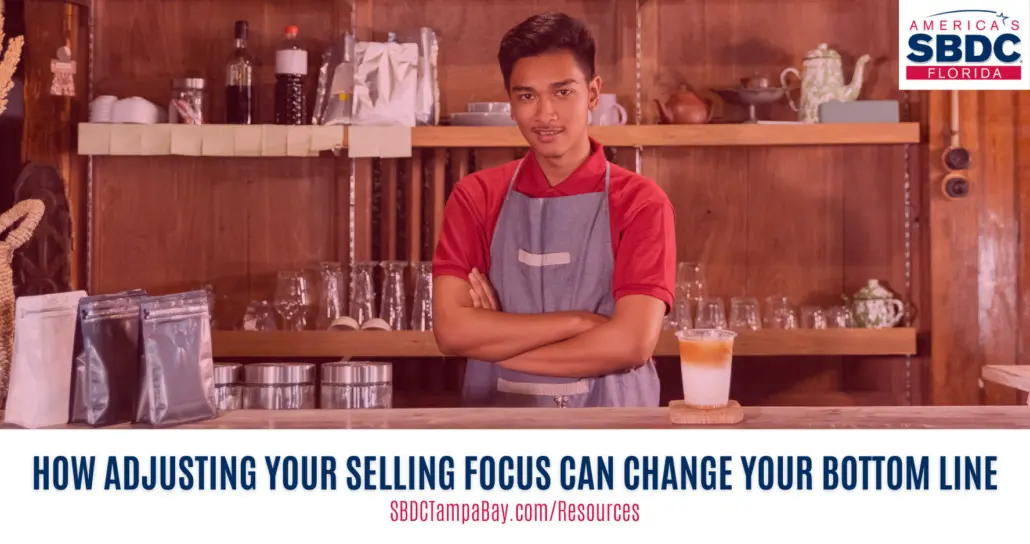How Adjusting Your Selling Focus Can Change Your Bottom Line

by Christine Jaros | October 30, 2023
Are your sales stagnant? Steadily dropping off? There are numerous reasons why your sales could be experiencing a decline – like pricing issues, competitive encroachment, poor quality, stale or inadequate selection, market saturation, an economic or supply chain downturn, or new socio/political trends. Perhaps instead, it’s simply a selling issue you have in marketing your brand. Consider these five selling shifts in focus that can help you turn your selling trend from negative to positive.
What Is Your Customer’s Pain?
In sales, we often define the concept of “customer pain” as a challenge or problem the customer has not or can not solve. The process of identifying their pain points requires that you listen to your customer, ask questions, and gather information. Frankly, sometimes the customer doesn’t know what is wrong. Being able to diagnose their challenges and problems means you will have to become familiar with their situation which could include psychographics (the attitudes, tastes, and preferences of your target market).
Are they short on time? Do they have budget constraints? Have they had similar products that don’t work or meet expectations? Does the market lack the selection of product, they seek? Salespeople often tend to want to do all the talking but this is when sellers need to talk less and ask more questions because it’s not about them, their pitch, or the script. Customer pain is about the customer’s needs. Listen and diagnose based on what they say, and what your market research tells you. Ultimately, the conversation will take them down a path that matches their pain with your solution – your product/service.
Connect With Your Customers
Show empathy for the customer’s point of view and purchasing concerns. Relate to them in a conversation, not a script or pitch. Establishing trust comes with engaging your customer in a real conversation, and not about the weather. Here you reveal yourself as a person, not a seller with the goal of grabbing their money. More so, you show an ability to relate to their problems, challenges, and concerns on a human level – not robotic or mechanical which comes from a prefabricated selling document.
Being authentic and empathetic distinguishes you from others. A customer wants to buy from someone who is going to tell them their real story, give them honest feedback (even if bad), and help them review their choices or even decide. Remember, it’s about them, not you. If your product/service isn’t right for them, let the customer know. If a competitor has a better fit, tell them. Honesty will ultimately pay off in referrals. Letting the customer know you’ve got their back creates that customer pipeline that lasts decades, not days.
Disqualify A Bad Fit
Too often sellers waste precious resources on non-productive customers or territories. Using a bass fishing example, some cast a wide net believing that no matter what, they will achieve their desired catch but, if they are fishing in the wrong waters (the ocean), this is not true. Furthermore, the probability of catching the right fish (Bass) might yield a less than desired outcome. Hoping for ideal results does not bring them. You need to qualify your customers, your sales calls, and your territories if you want them to be fruitful.
Are you trying to sell snowplows in south Florida? Of course not, because we don’t get snow here. Fitting your product/service to your target market is critical. You will have primary customers, secondary customers, and even tertiary customers. Here I use the example of Raymond James Stadium in Tampa, Florida. You are on the field selling alongside all others like you (your competition). Your primary customers are in the front rows, secondary in next level up, etc. If you’ve qualified your customers, those primary ones should respond. Getting the secondary and tertiary customers will take more work but once you determine they aren’t right, move on. Perhaps they are not ready now and can one day be a customer. It’s ok to seed the future potential of a sale but know your limits and realize where you need to call it a day and move onward.
Know How to Handle Any Objection to Your Product/Service
Being good at prospecting, cold calls, presentations, market solicitations, estimates and demos are great, but its not enough. Face it. You are going to get ‘no thanks’, ‘not now’, and abandoned carts. And for those with whom you are face-to-face, they may tell you why. Your ability to be authentic and handle customer objections is critical in overcoming a negative end pass and closing a sale/converting a cart. You can’t use a script for this, you must be better than practiced. You must be real and fluid.
Pre-empt these objections throughout your conversation. And engage your customer in acknowledging them as well in a feedback loop. These feedback loops are simply inquiry points within your conversation asking your customer’s opinion/feedback. You don’t want the end of conversation pile-on, where your customer fires away with every concern on earth. By subtly addressing these issues throughout the conversation and engaging responses, you are overcoming the resistance and bringing the customer in closer to a yes.
ABC’s of Selling – Always Be Closing
No matter what kind of selling you are doing, it’s a two-way dialogue that only works if the customer is engaged. Being authentic and empathetic sets the tone for an honest conversation. Coming across with hyper enthusiasm will scare them away. Knowing the market, the demographics, the attitudes, tastes, preferences, and needs will demonstrate your commitment to providing value. Remember, it’s about them, not you. Tie their pain points to a solution that your product/service can provide. This will fill the pain gap with something they value and if your product/services aren’t right for them, let them know. Reiterate, you’ve got their back. This builds long lasting relationships. Use feedback loops – like hugs they pull people closer to a buy throughout the process so by end of process, they are already there. Take a step back, no pressure, put on your customer’s shoes. By now you’ve well explained the value that is in it for them.
Don’t sell, communicate – BE REAL. Again, It’s about the customer, not you.





Christine Jaros
Consultants, Jaros, TampaSpecialties: E-commerce, Marketing & Sales, Startup Assistance, Organizational Development Christine Jaros provides business consulting in the areas of startup, business plan development, marketing and sales, e-commerce, finance, wholesaling and retailing, and business management. Before joining the Florida SBDC at USF, Jaros owned her own apparel wholesale sales and consulting business in New York City for 14 years. She has more than 35 years of experience as a professional businesswoman. Jaros built a global-focused career specializing in manufacturing, marketing and sales with organizations including Bidermann Industries, Liz Claiborne Inc, and Hartmarx Corp. Working with iconic brands such as Yves Saint Laurent, Liz Claiborne, Calvin Klein, Polo-Ralph Lauren and Austin Reed, Jaros grew her portfolio of skills to include international sourcing and distribution. She is a certified TTI DISC Certified Professional Behavioral Analyst and TTI DISC Certified Professional Driving Forces Analyst and a certified Associate Business Continuity Professional (ABCP). Jaros obtained her bachelor’s in business management and marketing from Ohio University. She went on to study fashion and apparel in Paris, France, and later received a finance-focused Executive MBA from Pace University in Manhattan.